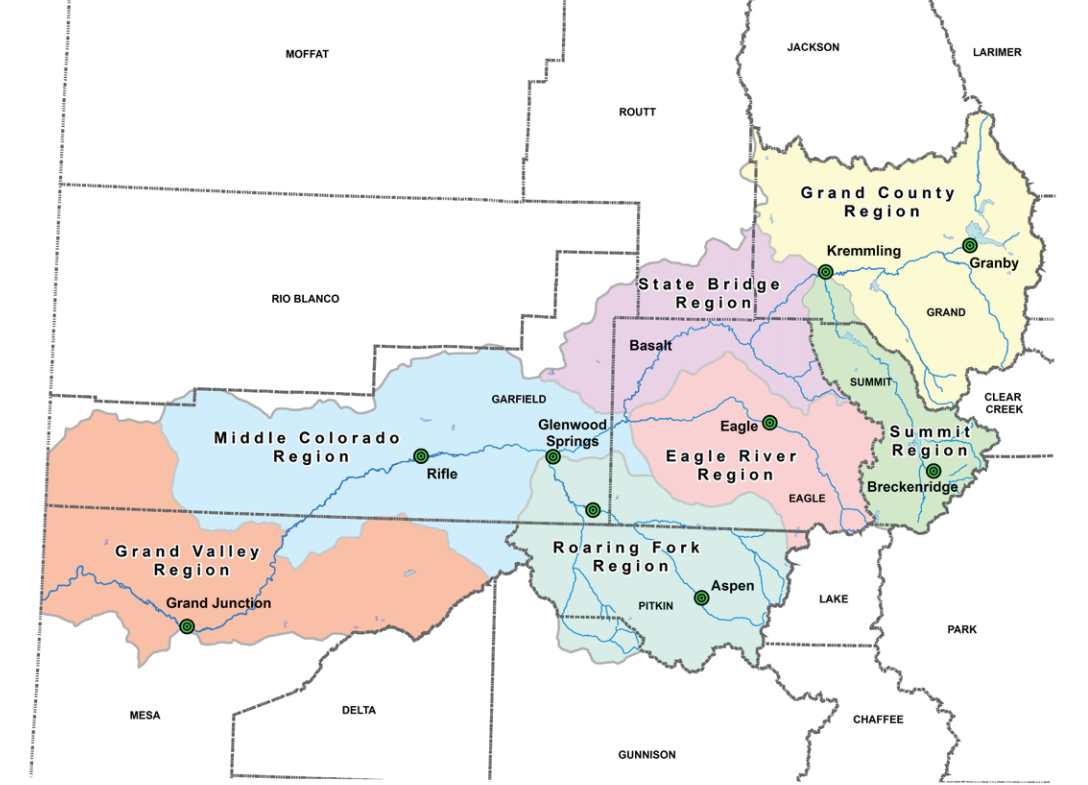Basin Implementation Plan
Home >> Colorado Water Plan >> Basin Implementation Plan
2023 Basin Implementation Plan (BIP) Update
The Colorado Basin Roundtable (CBRT) is actively working on updating its 2015 Basin Implementation Plan (BIP). SGM is the Local Expert for the BIP Update and has engaged stakeholders from across the seven unique regions (Grand County, Summit County, State Bridge, Eagle River, Roaring Fork, Middle Colorado, and the Grand Valley) to support this effort. SGM is working alongside Brown and Caldwell, the General Contractor assisting the Colorado Water Conservation Board (CWCB), to update the Identified Projects and Processes (IPPs) that will inform the Colorado Water Plan (CWP) and the future direction of the CBRT.
Initial efforts are underway to identify municipal and industrial, agricultural, and environmental and recreational projects that will meet the six themes of the CBRT, and ultimately, minimize the “gaps” between the existing and projected demands and water supplies.
Read the Executive Order & Colorado Water Plan
Collaborating on Colorado's Water Plan
Forward by the former Chair of the Colorado Basin Roundtable
In 2015, as part of a statewide initiative to develop Colorado’s Water Plan, the Colorado Basin Roundtable completed its own Basin Implementation Plan (BIP) to address water needs within the main-stem Colorado River basin in Colorado. The BIP contains sections to address the needs of each of the basin’s subregions, from Grand County to the Grand Valley.
“The Colorado Basin Roundtable’s Basin Implementation Plan takes a firm position that when it comes to the Colorado River, another big transmountain diversion of water from our basin to the Front Range of Colorado would damage the regional recreation-based economy and heap further impacts on the environment and agriculture.
HERE’S WHY: Between 450,000 and 600,000 acre feet of Colorado River water already permanently leaves the basin annually through existing transmountain diversions. It’s 100 percent gone, none of it coming back into the system through return flows. What’s more, a number of the Roundtable’s constituents have signed or are working on prospective agreements that could move up to another 140,000 acre feet through various projects. In other words, we already face a transmountain-sized project.
HERE’S THE WORRY: Existing streamflows are critical to sustaining the recreational economy in our basin, which is home to the state’s most popular ski resorts as well as robust rafting, fishing, and hunting industries and other sought after outdoor experiences. Agriculture in the basin, especially in the Grand Valley area, remains a vital pursuit of statewide interest that depends on water supply. Further degraded streamflows threaten higher levels of pollutants.
HERE’S ANOTHER WORRY: If Colorado overdevelops the river system beyond Colorado River Compact of 1922 legal limits, curtailments loom for many water users, perhaps most significantly for current transmountain diverters. Colorado already knows this compact lesson from other instate basins: over development of a river ultimately means undevelopment of agriculture to deal with the legal consequences.
For these and many more reasons spelled out in this document, we discourage the assertion that a transmountain diversion is in this state’s best interest. Still the Colorado Constitution does not permit the legal argument of “not one more drop.” So we make the case that Colorado should take immediate steps to best use the water it already has. Painful deliberations about per capita consumption, land use and landscaping lie ahead.”
Jim Pokrandt
Colorado River Water Conservation District
and Former Chair of the Colorado Basin Roundtable
RFQ for Updating the Colorado Basin Implementation Plan
- “Procurement Process and Roles for Local Experts 1-15-2020.pdf”. This document has a cover sheet describing the content of the packet. It also includes a 2-page summary of the procurement process and the anticipated duties and characteristics of the Local Expert.
- “BIP Update Framework and Overview – 1-15-2020.pdf”. This document is an expansion and update of the 2-page summary of the BIP Update framework and overview that CWCB included in the C-9 Summit handouts. It provides some context for the BIP Updates and a general description of the “core” BIP Update goals and content.
- “Timeline Summary for BIP and CWP Updates – 1-15-2020.pdf”. This is a 2-page summary that has timelines showing 1) the overall BIP and Water Plan Update process and 2) a summary of BIP Update activities in 2020.
- “Anticipated Scope of Services for LEs – 1-15-2020.pdf”. The Anticipated Scope of Services will be an attachment to the RFQ, and it describes the anticipated activities and characteristics of the Local Expert.
- Responses to Questions from Prospective Local Experts – View Addendum #1 Q&A.
- Responses to Questions from Prospective Local Experts – View Addendum #2 Q&A.
2015 Basin Implementation Plan (BIP) Introduction
Colorado is facing significant water supply challenges to meet future demands. These challenges are driven by a growing population, agricultural needs, protecting and restoring river health, and a growing recreation economy. In response, Governor Hickenlooper issued an Executive Order (EO) in 2013 calling for the Colorado Water Conservation Board (CWCB) to work with the nine Basin Roundtables, the Inter Basin Compact Committee (IBCC), and other stakeholders to develop Colorado’s first Water Plan. Each of the nine Basin Roundtables were charged with (Figure 2) developing a Basin Implementation Plan (BIP), identifying how future municipal and industrial, agricultural, recreational and environmental water needs will be met through existing or new projects, policies, and processes to the year 2050. The Governor’s EO required that the Colorado Water Plan incorporate the following key water values:
- A productive economy that supports vibrant and sustainable cities, viable and productive agriculture, and a robust skiing, recreation and tourism industry.
- Efficient and effective water infrastructure promoting smart land use.
- A strong environment that includes healthy watersheds, rivers and streams, and wildlife.
Initial drafts of the Basin Implementation Plan were due in July of 2014 with final drafts due in April 2015. What follows is the outgrowth of countless Roundtable meetings, robust public outreach including 45 community meetings reaching over 900 stakeholders and countless hours of work by consultants, Roundtable members and the public.
The Colorado Basin Roundtable (CBRT) submits this Basin Implementation Plan (BIP) as its contribution to Colorado’s Water Plan. In Governor John Hickenlooper’s May 2013 Executive Order he called for the state to create a water plan that proposes water-supply solutions for Colorado’s growing population, which according to the State Demographer could double to 10 million people by 2050. The Colorado Water Plan will be the culmination of more than nine years of work by nine basin Roundtable across the state, including the Colorado Basin Roundtable.
A primary objective of the BIP is to look inside the six counties for projects and processes that will define the mainstem Basin’s water supply future and environmental needs. This BIP does that and it is a first-time aggregation of the many and varied ideas, projects, conditional water rights and environmental concerns that exist across the Basin. It does not favor one project over another but focuses on the needs of consumptive and non consumptive uses within the Basin. While focusing on intrabasin needs by necessity it also addresses other basins looking to the Colorado River system to help solve their water supply Gaps, by moving additional Western Colorado water across the Continental Divide to the Front Range. Current and future proposed projects by out of basin users are referred to as Transmountain Diversions, or TMDs within this BIP.
Influenced by a Grassroots Effort
The Colorado Basin Roundtable initiated an extensive Public Education and Outreach program in December of 2013 that included more than 6 Town Halls, 20 Roundtable and project leadership team discussions, 30 one-on-one interviews with water providers, 45 public outreach presentations to City and Town Councils and several college forums. From Grand County to Mesa County the public emphasized the importance of not overusing the Colorado River beyond its sustainable carrying capacity and stressed the need to restore and protect the essential flows and water quality of the Colorado River. These outreach efforts connected with more than 900 citizens across the seven regions of the Colorado River Basin, offering them the unique opportunity to voice their concerns and offer solutions on how to meet future water demands within Colorado River Basin well beyond 2050. Public Education and Outreach efforts provided the basis for the Colorado Basin Implementation Plan. The six themes that arose from the outreach portray the voices of the Colorado River Basin stakeholders, the agricultural community, municipalities, water providers, watershed groups, conservancy and conservation districts, government officials, students, and the public. The six themes are:
1. Protect and Restore Healthy Streams, Rivers, Lakes and Riparian Areas
2. Sustain Agriculture
3. Secure Safe Drinking Water
4. Develop Local Water Conscious Land Use Strategies
5. Assure Dependable Basin Administration
6. Encourage a High Level of Basinwide Conservation
Water projects have been identified by Basin stakeholders to proactively address these themes to support future consumptive and nonconsumptive (environmental and recreational) water projects. However, the overarching solution to meeting all six themes is to not develop additional transmountain diversions from the Colorado River Basin for other basins.
Regional Breakdown
Each of the regional sections begins with a brief description of the region followed by a series of three maps that depict the existing consumptive uses, environmental and recreational conditions, and top identified projects. This existing conditions information was used by the regional stakeholders to develop the most relevant Basinwide themes and associated vulnerabilities for that region which in turn helped identify methods and top projects in meeting future needs. Focusing on specific goals, vulnerabilities, needs and top projects within each region is not intended to split the basin but instead draw the Basin together through better understanding of how the Basin-wide themes are prioritized.
The regional boundaries were delineated based on the State Engineer Office’s (SEO) water district boundaries. Several regions mimic the exact SEO district boundaries while some were a combination of several districts and in one instance; the Middle Colorado Region, was enlarged to include the Shoshone Hydroelectric Plant.
Seven Basin Regions
- Grand County
- Summit County
- State Bridge
- Eagle River
- Middle Colorado
- Roaring Fork
- Grand Valley


